- 1College of Grassland Science and Technology, China Agricultural University, Beijing, China
- 2State Key Laboratory of Animal Nutrition, College of Animal Science and Technology, China Agricultural University, Beijing, China
- 3College of Animal Science, Guizhou University, Guiyang, China
High-moisture corn silage presents a novel approach to reduce forage feeding expenses and enhance animal performance. Nevertheless, given corn’s proclivity for starch, suboptimal fermentation quality in high-moisture corn silage can lead to spoilage, posing risks to livestock well-being. Therefore, the objective of this study is to evaluate the effects of different additives on the fermentation profile, chemical composition, nutrient digestibility of high-moisture corn (HMC) silage. All treatments improved the quality of high-moisture corn silage fermentation, as demonstrated by a decrease in pH and increase in lactic acid (LA) content. The high-moisture corn silage had a low content of trans fatty acids (TFA). Fermentation effectively decreased prolamin content while increasing 48-h in vitro dry matter digestibility (IVDMD), estimated total tract starch digestibility (eTTSD), total digestible nutrient (TDN), and relative grain quality (RGQ) of high-moisture corn silage. Nonetheless, no effect was observed on the 48-h IVDMD of high-moisture corn silage among the different treatments. Pearson’s correlation analysis indicated that neutral detergent fiber (aNDF), neutral detergent insoluble protein (NDIP), crude protein (CP), zein, and prolamin closely correlated with the digestibility of high-moisture corn. The study’s findings demonstrate that inoculating L. buchneri and potassium sorbate can improve the quality of high-moisture corn silage fermentation and digestibility in different hybrids. The results will provide insights for enhancing farm productivity and profitability in China.
1 Introduction
High-moisture corn has served as a high-quality livestock feed, especially for ruminants and pigs, in North America and Europe more than seven decades (1, 2). Given the high latitude of the region, large-scale corn cultivation is common in Northeast China, where it can be challenging for corn to accumulate the necessary temperature for maturation (3). Consequently, corn is typically harvested in this region every October, with local farmers predominantly depending on natural drying methods to produce dry corn grains. Regrettably, this drying process frequently carries the risk of mold formation, originating from overly dense corn piles or elevated ambient humidity levels (4). To address these challenges, high-moisture corn has emerged as a new method to overcome the challenges of corn harvesting in Northeast China. It offers advantages, including earlier harvesting and decreased vulnerability to weather conditions. Consequently, high-moisture corn silage has gained popularity among dairy farms in recent years, as it is considered a vital approach to promote sustainable pasture development. This aligns with the Chinese government’s policies encouraging optimization of feed practices and environmental sustainability in the dairy industry.
Unlike other types of silage, high-moisture corn presents unique challenges during the fermentation process due to its high dry matter content (68% and above), which can make it difficult to lower the pH of the fermentation environment (5). Additionally, high-moisture corn silage is conducive to yeast reproduction, which can lead to starch loss and compromise feed quality (6). Lentilactobacillus buchneri was the most widely used lactic acid bacteria that can inhibit the growth of undesirable fermentation and spoilage microorganisms by producing acetic acid (7). It can also be used as a probiotic to improve animal production performance and ruminal fermentation (8). Gallo et al. (9) assessed the impact of inoculating L. buchneri at various silage densities and found that inoculation can enhance fermentation quality while reducing the contents of fumonisin B2 and roquefortine C. For high-moisture corn, inoculation with L. buchneri effectively inhibited yeast growth and reduced the relative abundance of Enterobacteriaceae in both the silage and under air stress conditions (10). In addition, acid/salt-based additives including acetic acid and potassium sorbate are commonly applied in silage to prevent feed spoilage (11, 12). Furthermore, silage inoculated with homofermentative lactic acid bacteria tends to have higher yeast counts due to lower acetic acid concentrations. Da Silva et al. (2) reported that using additives with potassium sorbate, sodium benzoate, and sodium nitrite as the main ingredients (at nitrite concentrations within the safe range) improved the aerobic stability and dry matter recovery of high-moisture corn silage. Hence, we believe that using additives in high-moisture corn silage preparation to inhibit deleterious microflora, improving fermentation quality and feed preservation.
Prolamins, often referred to as reserve proteins, are primarily located in the corn grain’s endosperm. Owing to their deficiency in essential amino acids alongside an abundance of non-essential amino acids, they are regarded as nutritionally inferior proteins for animal feed (13). Corn starch prolamins are encapsulated within a hydrophobic prolamin matrix, which hinders microorganisms accessibility to starch (14, 15). Previous studies (16, 17) have shown that proteolytic bacteria and plant enzymes degrading prolamins during silage improve rumen utilization and total tract starch digestibility. However, this natural proteolysis process may require up to 10 months for the protein matrix to hydrolyze to an extent that optimizes starch availability in corn silage (12). Fernandes et al. (15) observed that for different hybrids of high-moisture corn and water-rehydrated corn (RC), the hybrid type and water content did not affect the 24-h dry matter digestibility (DMD) and starch digestibility (starchD) of the same hybrid, but HMC and RC reduced the influence of vitreousness on digestibility. Therefore, selecting appropriate additives to promote the breakdown of prolamins is a crucial consideration in high-moisture corn silage preparation, in order to ensure optimal silage quality.
Therefore, this study selected two widely planted corn hybrids in Northeast China, ZN787 and LXN, to evaluate the effects of using different additives on the fermentation profile, chemical composition, and nutrient digestibility of their corn grains. The findings of this study will contribute to the advancement of high-moisture corn silage production in China and provide new dietary formulation options for pastures.
2 Materials and methods
Corn was sown on May 13, 2022, in the National Modern Agriculture Industrial Park of Horqin Left Middle Banner, Tongliao City, Inner Mongolia Autonomous Region, China (43°32′ ~ 44°32′N, 121°08′ ~ 123°32′E). During the planting period, seed fertilizer, nitrogen-phosphorus-potassium water-soluble fertilizer, and foliar fertilizer were applied (Whole-plant corn yield and chemical composition of the two hybrids are shown in Supplementary Table S1). Three plots of corn were randomly selected and manually harvested for each corn hybrid. The corn was manually dehusked and ground with a grinder. The grains of each corn hybrid were thoroughly mixed and randomly divided into 15 piles. Then 3 piles were randomly assigned to each treatment. Subsequently, the corn grains were subjected to different treatments: (1) Sterile deionized water (CON) (4 mL/kg) (2) Acetic acid treatment group (A4) (0.4 g/kg Fresh Weight, FW) (3) L. buchneri treatment group (LB) (1 × 106 cfu/g) (4) Potassium sorbate treatment group (PS) (2 g/kg FW) (5) Combined treatment group of L. buchneri and potassium sorbate (LB + PS) (1 × 106 cfu/g + 2 g/kg FW), all treatments were dissolved in sterile deionized water and sprayed evenly, the control group received the equal volume of water. Approximately 3 kg of treated corn was compacted into 3 L plastic buckets and sealed with two plastic screw top lids (inner and outer), and stored at an ambient temperature of approximately 20 ± 2°C.
After 45 days of ensiling, the high-moisture corn silage samples were retrieved from the silos, and a 25 g sample was mixed with 225 mL of sterilized distilled water and then rotated in the mixer for 2 min. Then the liquid was filtered through 4 layers of non-woven fabric and filter paper. The pH was determined by pH meter (FE28-Standard, Mettler Toledo). The filtrate was centrifuged at 10000 × g at 4°C for 5 min, and the supernatant was used to determine the Ammonia N content using the phenol-hypochlorite method (18). In addition, the supernatant was passed through a 0.22 μm filter membrane, and lactic acid, acetic acid, propionic acid, and butyric acid were determined using HPLC. The HPLC system consisted of a Shodex Rspak KC-811S-DVB gel column (30 mm × 8 mm) maintained at 50°C, an SPD-M10AVP detector, and a 3 mmol/L perchloric acid mobile phase. Detection was performed at a wavelength of 210 nm, and the injection volume was 5 μL (19).
Measurement of mean particle size (MPS) was conducted prior to silage using the People’s Republic of China national standard: Determination of feed particle size-geometric mean particle size method (GB/T 40994–2021). Raw material and silage samples were dried in a forced-air oven at 60°C for 48 h, and all dried samples were ground by a laboratory grinder and passed through a 1 mm sieve. Neutral detergent fiber and acid detergent fiber (ADF) were determined using the method of Vansoest et al. (20) with an Ankom2000 fiber analyzer. Crude protein (CP) was determined by the Kjeldahl method (21). Water-soluble carbohydrate (WSC) was determined using the method of Ke et al. (22). Ether extract (EE) and ash (Ash) were determined using the method of AOAC (23). Starch was determined by the method of McCready et al. (24). Neutral detergent insoluble protein (NDIP) was determined by the method of Licitra et al. (25). Additionally, 50 g samples were selected and dried at 55°C, and the concentrations of zein and prolamin (zein/starch) were determined according to the method of Larson and Hoffman (26). The composition of fatty acids was analyzed using gas chromatography (GC-2014 Shimadzu Corporation) with a modified method based on Qiu et al. (27). In vitro dry matter digestibility was performed using the Ankom RFS bottles and the pressure sensor technology described by Yuan et al. (28). Rumen fluid and buffer conditions were consistent with Xie et al. (29). Estimated total tract starch digestibility, energy and relative grain quality (RGQ) were evaluated according to the UW-Feed Grain Evaluation System (Marshfield Soil and Forage Analysis Laboratory, Hoffman and Shaver). The equations used for calculations were as follows:
Where:
Statistical analysis was performed using SPSS version 25.0. Independent sample t-tests were utilized to compare differences (p < 0.05) between the two corn hybrids raw materials. Two-way analysis of variance (ANOVA) was conducted using SPSS version 25.0 to analyze the data under the fixed effects of hybrid varieties and additives. In cases where interaction effects were significant, simple effect analyses were conducted using the GLM statement in SPSS. For data with a single fixed effect, either t-tests or one-way ANOVA was performed, and means were compared using the Tukey method. A significance level of p < 0.05 was used to determine statistically significant differences from the means.
3 Results
3.1 Chemical composition of raw materials
Table 1 shows the chemical composition of unfermented high-moisture corn. The DM and CP content were lower (p < 0.05) in LXN than ZN787, but aNDF, ADF, WSC, starch, EE and NDIP content were not affected (p > 0.05). The zein was affected by hybrid (p = 0.027), where LXN was 0.7 percentage-units greater compared to ZN787. Corn grains at ZN787 had a greater (p < 0.001) MPS than LXN.
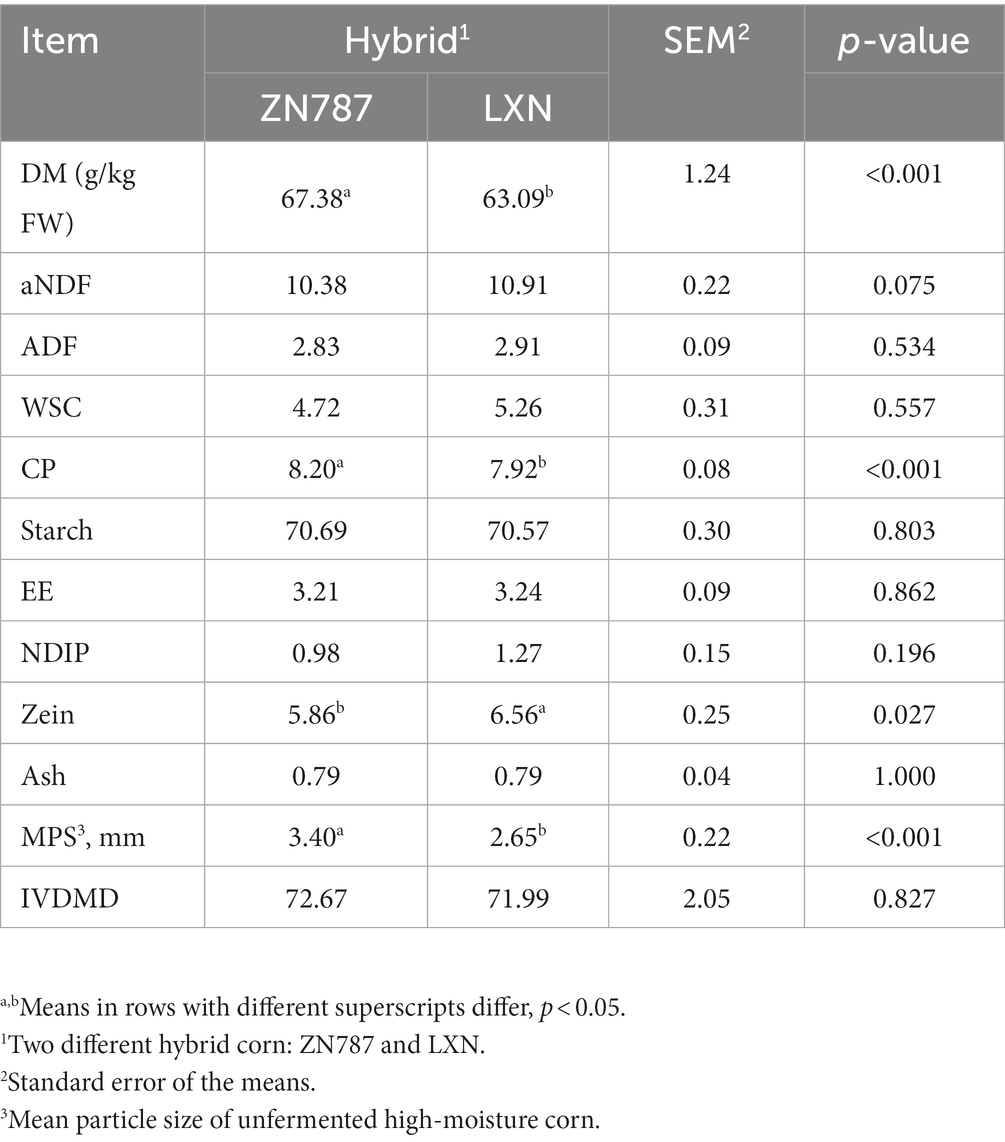
Table 1. The DM content, chemical composition and in vitro dry matter digestibility (%DM, unless stated otherwise) of raw materials.
3.2 Fermentation profiles in high-moisture corn silage
The changes in pH and concentrations of organic acids in high-moisture corn silage during 45 days of ensiling are shown in Table 2. The interaction between H × A was evident for pH (p = 0.006) and lactic acid (p < 0.001) content. After 45 days of ZN787 high-moisture corn ensiling, A4-treated and L + P-treated ZN787 silages had lower (p < 0.05) pH, PS-treated ZN787 silages had greater (p < 0.05) lactic acid content than CON. After 45 days of LXN high-moisture corn ensiling, LB-treated LXN silages had lower (p < 0.05) pH. A4-treated and LP + PS-treated ZN787 silages had greater (p < 0.05) lactic acid content than CON. A4-treated ZN787 and LXN silages had the highest (p < 0.05) acetic acid content, no clear variety (p > 0.05) for acetic acid content was observed in other treatment groups. The propionic acid levels were similar and low among treatments. Butyric acid in all silages was not detected. Additives had different effects on fermentation profiles of high-moisture corn silages, compared with the ZN787 silages, LB decreased pH (4.44 vs. 4.23) in LXN silages (p < 0.05), and elevated lactic acid (0.68 vs. 1.04) and acetic acid (0.34 vs. 0.60) contents (p < 0.05). Therefore, additives increased fermentation quality of ZN787 and LXN high-moisture corn silage.
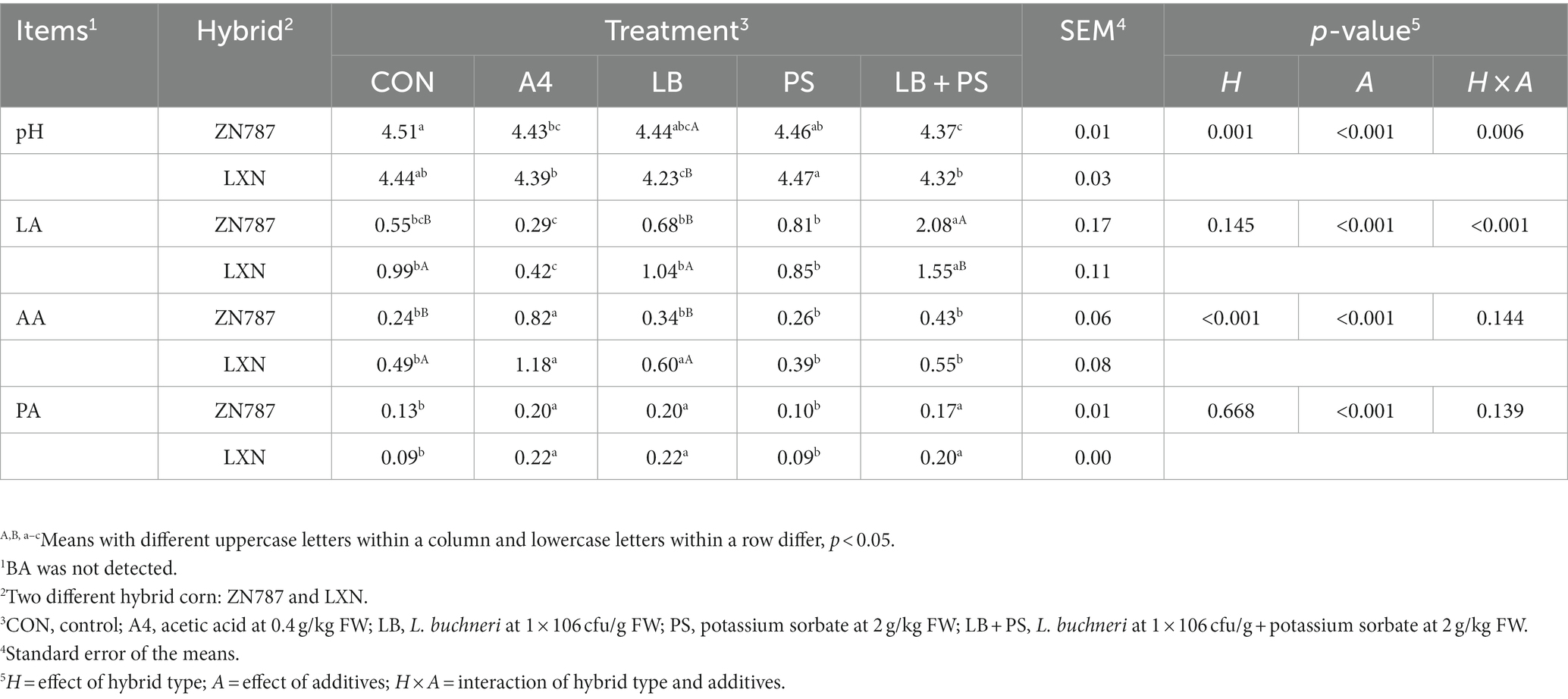
Table 2. The pH, fermentation products (%DM, unless stated otherwise) of high-moisture corn silage treated with different hybrid type and additive of ensiling.
3.3 Chemical compositions of high-moisture corn silage
As shown in Table 3, the interaction of H × A influenced contents of ADF (p = 0.013), zein (p < 0.001) and prolamin (p < 0.001). After 45 days of high-moisture corn ensiling, the NDF, starch and NDIP content was similar (p > 0.05) for both hybrids. The DM and EE content was higher (p < 0.05) for the ZN787 hybrid than the LXN hybrid, whereas, the zein content was lower (p < 0.05) for the ZN787 hybrid than the LXN hybrid. The addition of A4 decreased (p < 0.05) ammonia N concentrations as compared to the CON silage. The prolamin of ZN787 silage treated with L + P was lower (p < 0.05) than that of other treatment groups. Compared with the raw materials, the decreases in contents of NDF, NDIP and zein (p < 0.05, Supplementary Table S2) were observed in all treatments silage after high-moisture corn ensiling for 45 days, and the IVDMD of high-moisture corn silage was higher (p < 0.05, Supplementary Table S2) than that of the raw materials. No differences (p > 0.05) were observed in aNDF and starch from different hybrids or treatments.
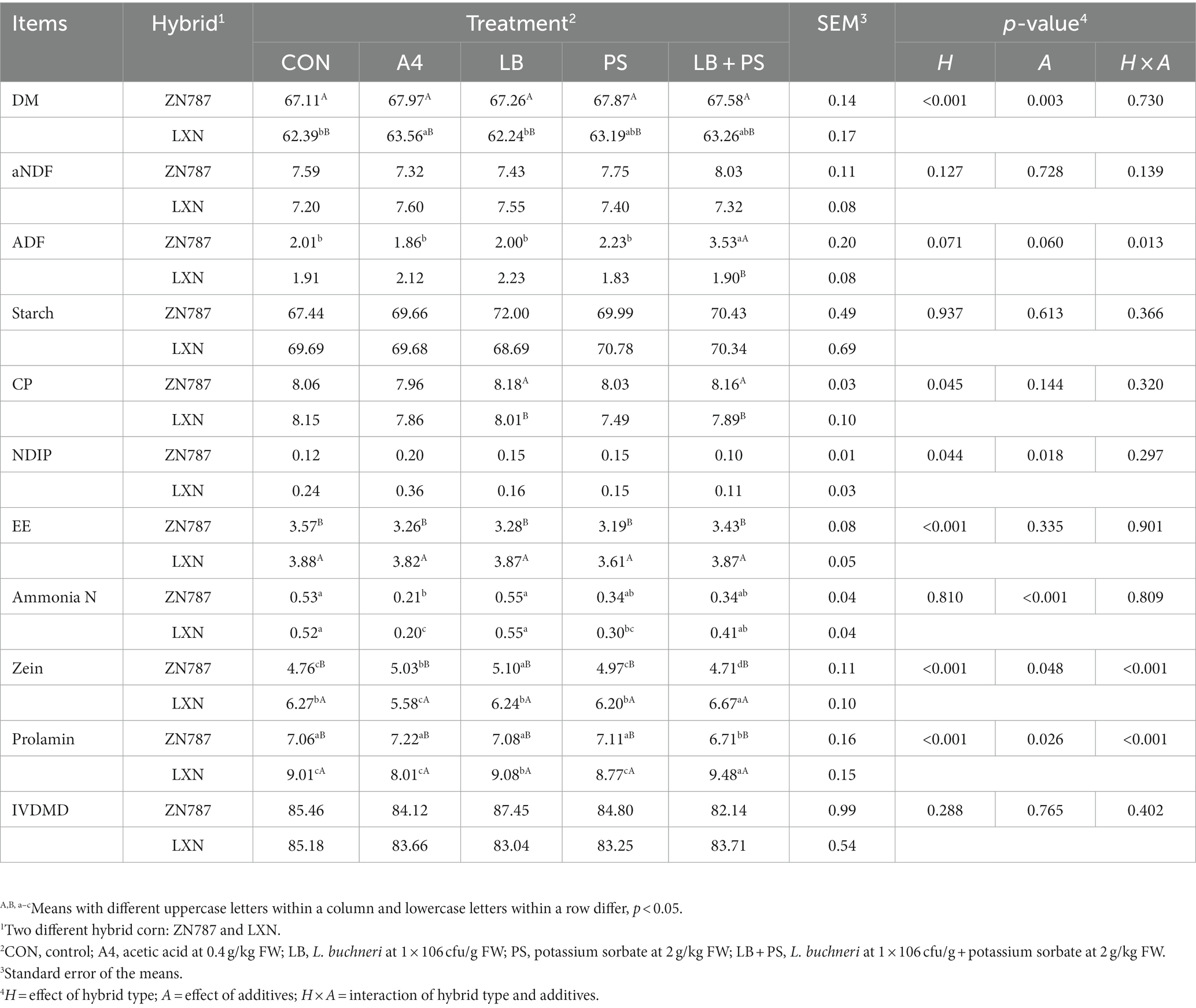
Table 3. The DM concentration, chemical composition and in vitro dry matter digestibility (%DM, unless stated otherwise) of high-moisture corn silage treated with different hybrid type and additive of ensiling.
3.4 Fatty acids profile of high-moisture corn silage
The fatty acids profile is listed in Table 4. The interaction of H × A influenced (p = 0.017) the contents of n-3. LB-treated increased (p < 0.05) the proportion of n-3 fatty acids in LXN silages. Linoleic acid (C18:2n6c) and oleic acid (C18:1n9c) were the two fatty acids with the highest content in high-moisture corn silage from two corn hybrids, and no differences (p > 0.05) were observed for them due to different additives treatment (Supplementary Table S3). In addition, low proportions of trans fatty acids were found in all treatments of ZN787 and LXN high-moisture corn silages.
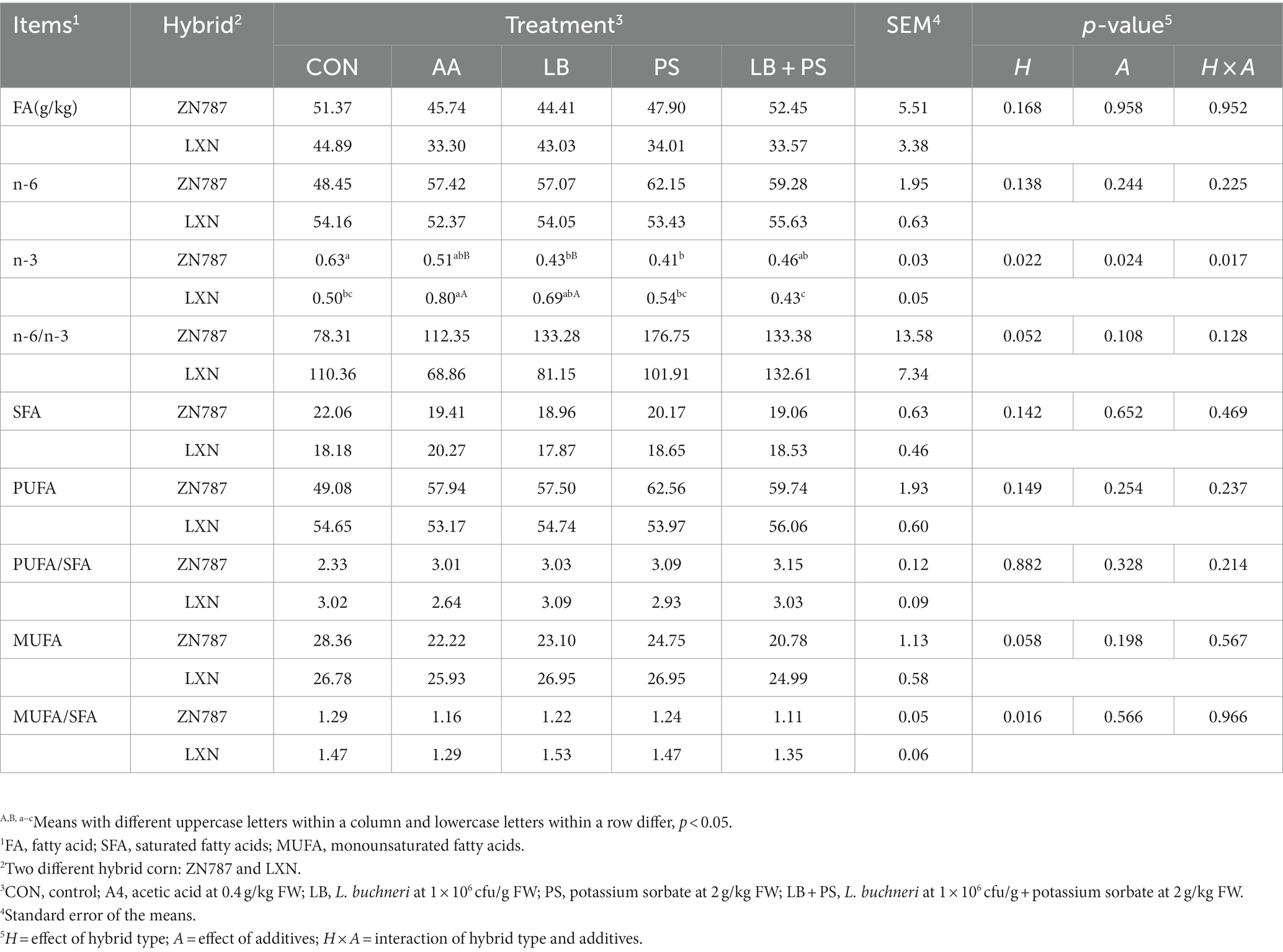
Table 4. The fatty acids profile (of total fatty acids, unless stated otherwise) of high-moisture corn silage treated with different hybrid type and additive of ensiling.
3.5 Estimated total tract starch digestibility, summative energy and relative grain quality of high-moisture corn silage
The summative energy, estimated total tract starch digestibility, total digestible nutrients and relative grain quality of HMC of the two hybrids are shown in Figures 1, 2. After 45 days of ensiling, all silages of eTTSD were higher than 89%DM, TDN higher than 83%DM and RGQ higher than 124, and LB-treated improve (p < 0.05) eTTSD of LXN. Both two hybrids of corn increased (p < 0.05) eStarch, eTTSD, TDN and RGQ compared to DG after 45 days of ensiling. The additives had similar effects on the two hybrids of high-moisture corn, and both increased (p > 0.05) eTTSD, TDN and RGQ. However, additives did not improve (p > 0.05) the energy and digestibility of high-moisture corn silage.
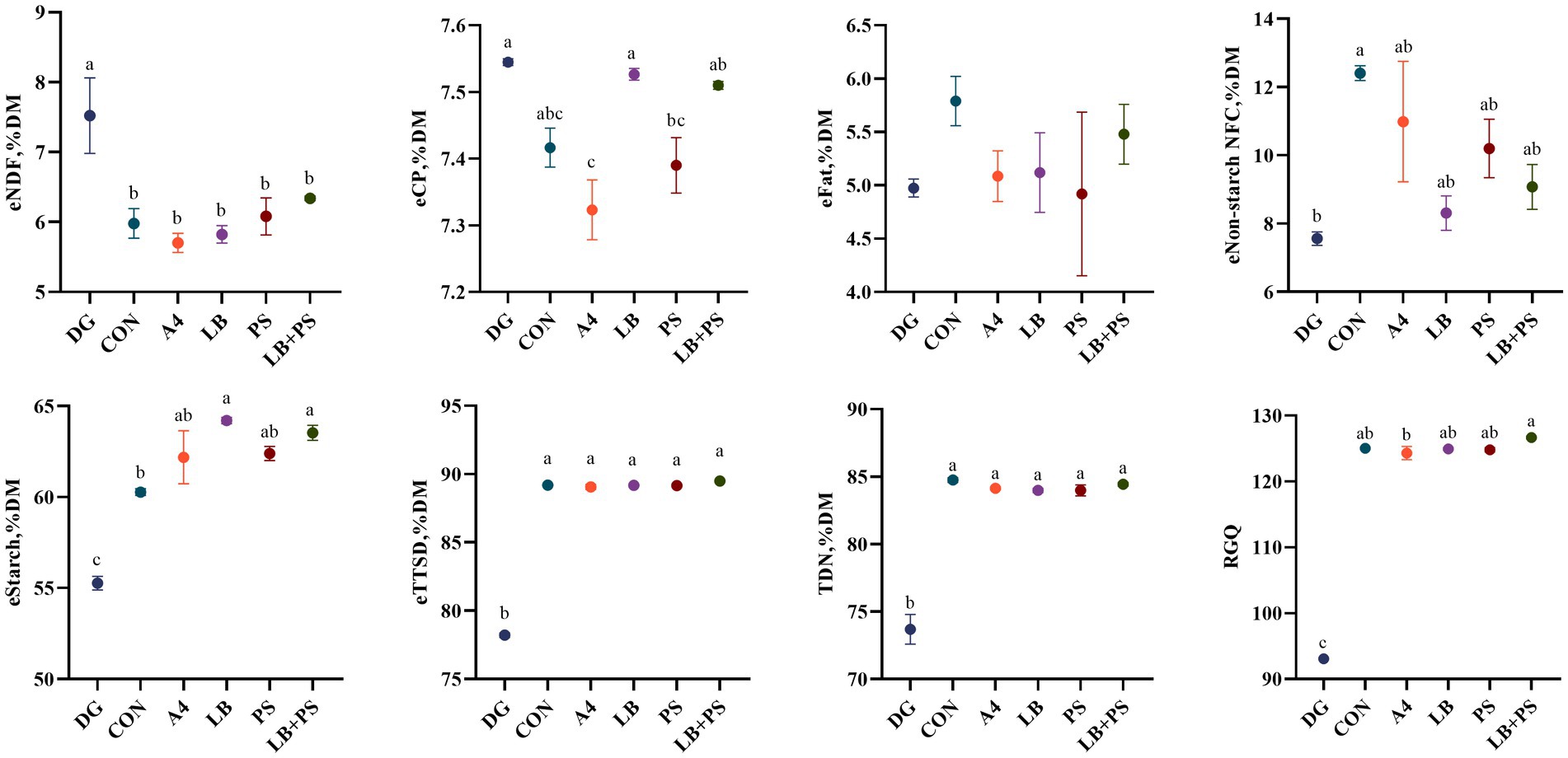
Figure 1. Effect of different treatments on the energy of neutral detergent fiber (eNDF), energy of crude protein (eCP), energy of fat (eFat), energy of non-fiber carbohydrate starch (eNon-starch), (eStarch), estimated total tract starch digestibility (eTTSD), total digestible nutrient (TDN) and relative grain quality (RGQ) of ZN787 high-moisture. Vertical bars are the standard errors of the means, bars with different letters differ (p < 0.05). DG, dry corn; CON, control; A4, acetic acid at 0.4 g/kg FW; LB, L. buchneri at 1 × 106 cfu/g FW; PS, potassium sorbate at 2 g/kg FW; LB + PS, L. buchneri at 1 × 106 cfu/g + potassium sorbate at 2 g/kg FW.
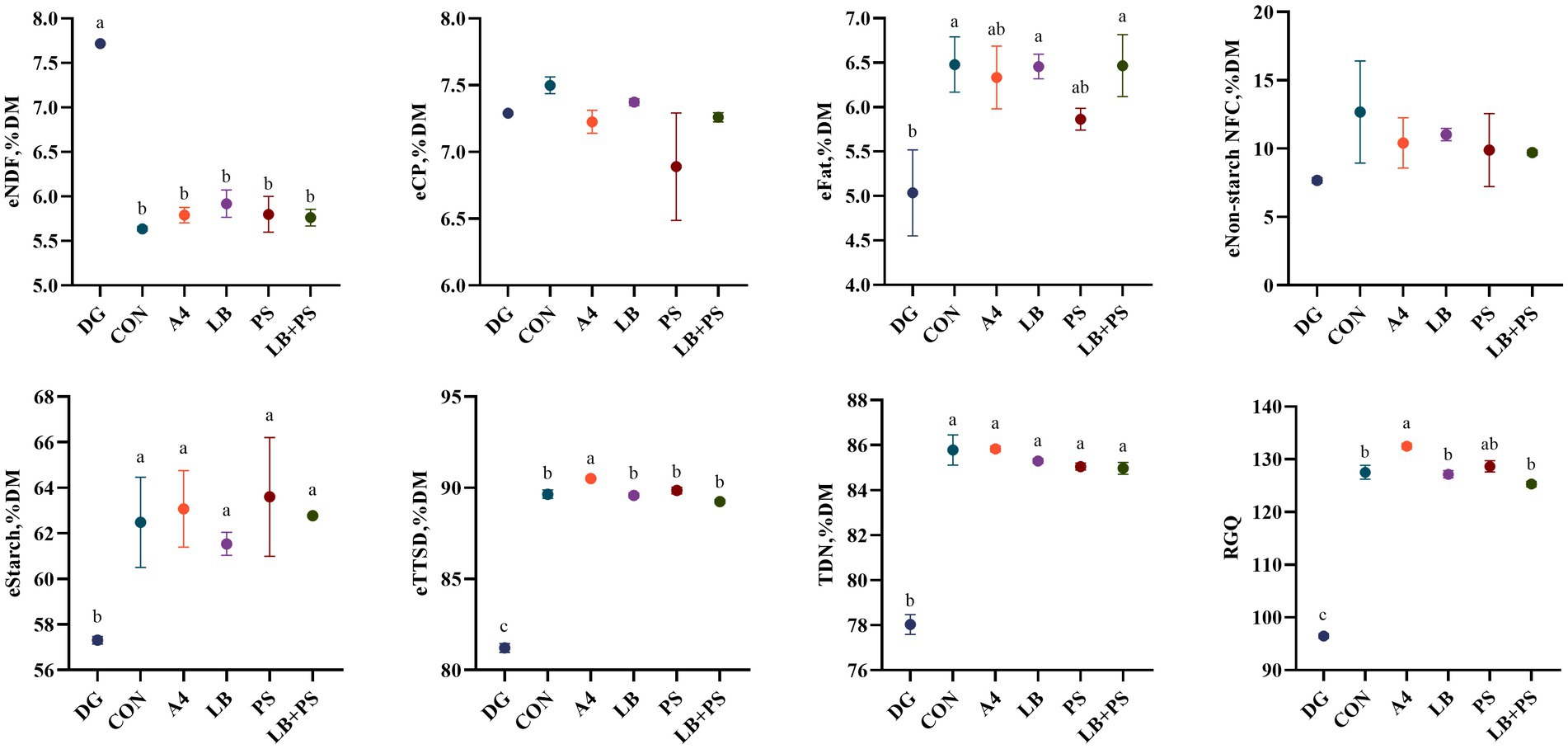
Figure 2. Effect of different treatments on the energy of neutral detergent fiber (eNDF), energy of crude protein (eCP), energy of fat (eFat), energy of non-fiber carbohydrate starch (eNon-starch NFC), energy of starch (eStarch), estimated total tract starch digestibility (eTTSD), total digestible nutrient (TDN) and relative grain quality (RGQ) of LXN high-moisture. Vertical bars are the standard errors of the means, bars with different letters differ (p < 0.05). DG, dry corn; CON, control; A4, acetic acid at 0.4 g/kg FW; LB, L. buchneri at 1 × 106 cfu/g FW; PS, potassium sorbate at 2 g/kg FW; LB + PS, L. buchneri at 1 × 106 cfu/g + potassium sorbate at 2 g/kg FW.
3.6 Correlation analysis of chemical components, digestibility and relative grain quality of high-moisture corn silage
Pearson’s correlation analysis shows the correlation between multiple indicators of high-moisture corn (Figure 3). Nine chemical components related to summative energy, digestibility and relative grain quality showed positiveor negative (p < 0.05) correlations. Among them, NDIP correlated negatively (p < 0.05) with the respiratory eStarch, eTTSD, IVDMD, TDN and RGQ. Furthermore, CP correlated positively (p < 0.05 with eStarch, eTTSD, TDN and RGQ), and corrleated negatively (p < 0.05) with prolamin and zein.
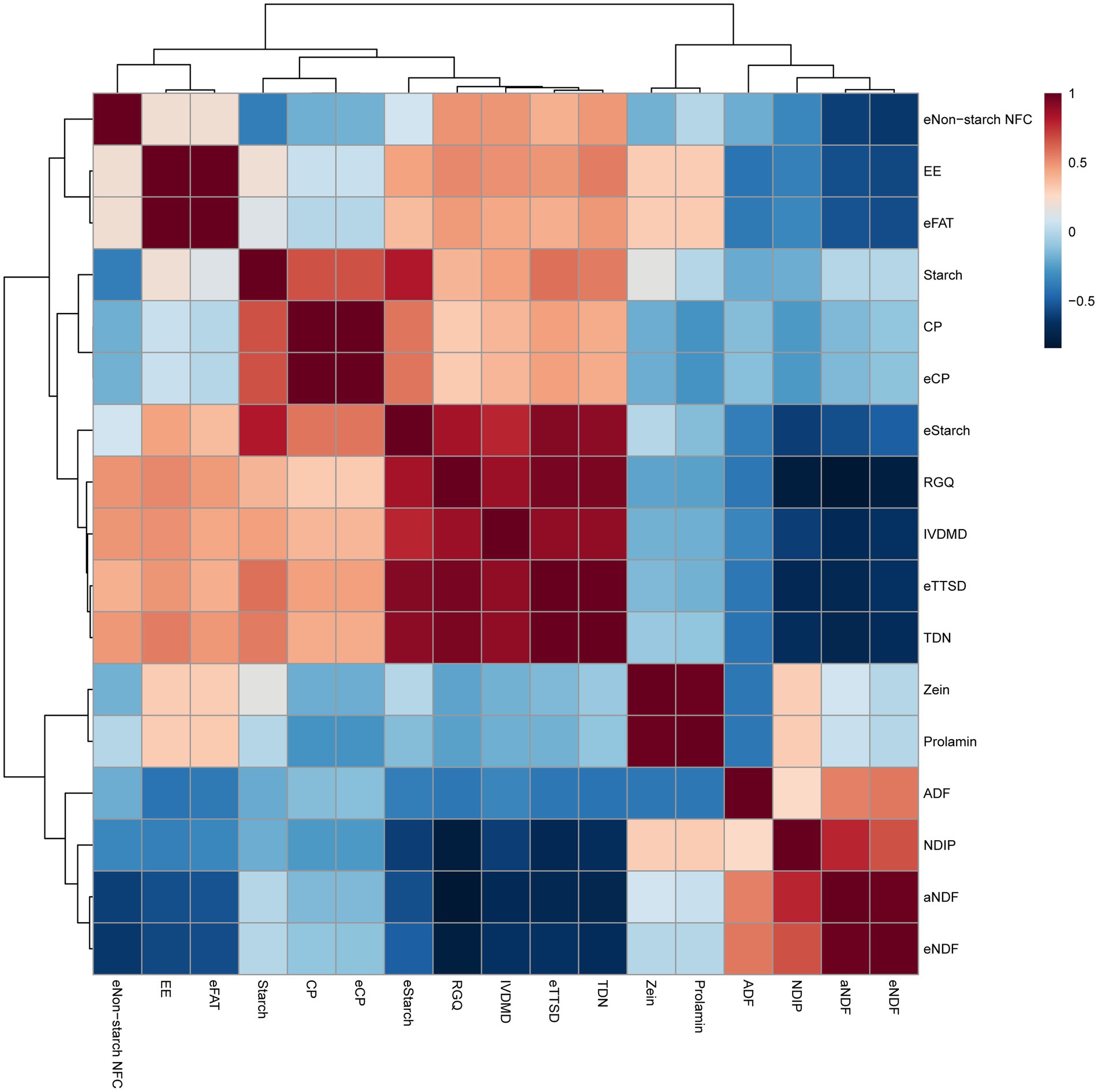
Figure 3. Pearson’s correlation matrix among chemical components, digestible profiles and grain quality of high-moisture corn silage. Positive correlations are displayed in red and negative correlations in blue. The correlation coefficients are proportional to numerical size and color intensity. aNDF, neutral detergent fiber; ADF, acid detergent fiber; CP, crude protein; EE, ether extract; NDIP, neutral detergent fiber crude protein; eNDF, energy of neutral detergent fiber; eFAT, energy of fat; eCP, energy of crude protein; eStarch, energy of starch; eNon-starch NFC, energy of non-fiber carbohydrate starch; eTTSD, estimated total tract starch digestibility; TDN, total digestible nutrient; RGQ, relative grain quality.
4 Discussion
The chemical composition of ZN787 and LXN high-moisture corn hybrids was consistent with previously reported ranges (2, 15, 17). However, there were variations in the dry matter and mean particle size of ZN787 and LXN high-moisture corn at the mature stage due to hybrids differences. Mestres et al. (30) reported that high-moisture corns lead to lower MPS because it is easier to grind. Generally, endosperm type influences zein content in corn; vitreous endosperm contains abundant zein, while floury endosperm has lower zein content (31). In this study, the lower zein content in ZN787 could potentially be attributed to its higher proportion of floury endosperm. Although decreased pH and elevated lactic acid levels are widely recognized as primary indicators of adequate fermentation, pH alone does not fully evaluate silage quality. Given that high dry matter materials intrinsically demonstrate higher pH exceeding 4.2, a more holistic assessment encompassing dry matter loss, microbial composition, and other parameters is warranted (32). In contrast to the findings of Da Silva et al. (2, 33), our study on high-moisture corn hybrids deviated from the anticipated pH levels below 4.2. This discrepancy may be influenced by the type of corn endosperm or the mean particle size. In a study by Fernandes et al. (15), they investigated the fermentation process of high-moisture corn with different endosperm types and observed that the pH of high-moisture corn silage with flint hybrids exhibited a more rapid decrease and reached a lower pH after fermentation. In contrast, Saylor et al. (17) obtained high-moisture corn silage with a pH range of 3.4–3.6 by crushing the corn to smaller mean particle sizes of 1.002 and 1.046. Additives play a critical role in silage preparation, including whole-plant corn, oats, alfalfa, and others. Among the options for silage production, chemical additives and microbial additives are commonly employed. Consistent with this, the addition of the additive increased the lactic acid content in the silage compared to the control group, indicating an accelerated fermentation process for high-moisture corn. The highest lactic acid concentration was observed when inoculated with L. buchneri and potassium sorbate. This might be attributed to the antifungal activity of potassium sorbate against yeast, enabling the preservation of more fermentable substrates for lactic acid bacteria during the early fermentation stage. Yuan et al. (34) reported similar findings for high moisture whole-plant corn silage, as the use of natural additives limited yeast accumulation. Furthermore, potassium sorbate not only improves aerobic stability but also limits the production of ethanol, ethyl lactate, and ethyl acetate during silage fermentation (35). Its addition can improve the quality of silage with high starch content, such as high-moisture corn.
In high-moisture corn silage preparation, the development of a black layer on corn serves as a visual indicator the optimal maturity for harvesting (1). In this experiment, the two corn hybrids differed in moisture content; the LXN hybrid had an approximate moisture content of 37% during ensiling. Gomes et al. (36) reported rehydration percentages of 30, 35, and 40% for reconstituted corn grain (RCG), finding that different levels of rehydration resulted in good quality RGC, consistent with the findings of the two corn hybrids with different water content in this study. Ruminant products are a primary source of medium-chain saturated fatty acids (MCFAs) and trans fatty acids (TFAs) in the human diet. Fatty acids play a crucial role in health and associated risks. Dietary recommendations have long emphasized replacing saturated fatty acids (SFA) with polyunsaturated fatty acids (PUFA). Altering the fatty acid composition in ruminant diets can influence animal product performance, subsequently affecting human health and cardiovascular well-being (37–40). In this study, we found that high-moisture corn silage contain ample fatty acids but had relatively low levels of trans fatty acids (TFA) (C18:1n9t, C18:2n6t, Supplementary Table S3). Therefore, it can be used as a high-fatty acid diet for ruminants, helping to prevent ruminal acidosis and address energy supply limitations in ruminant animals. High-moisture corn silage had low proportions of n-3 fatty acids, and although the additives exhibited differential effects between the two hybrids during fermentation, their effect was generally small. Previous studies have shown that field wilting (41), fermentation temperature (42), and additives (43, 44) can all impact n-3 fatty acids in silage. Additionally, Li et al. (45) reported that three strains of L. plantarum had differential effects on the fatty acid profile of alfalfa silage. Currently, there is insufficient evidence to illustrate how additives affect n-3 fatty acids, necessitating further research. Linoleic acid (C18:2n6c) emerged as the primary fatty acid in high-moisture corn silage, capable of undergoing isomerization in the rumen to create conjugated linoleic acid (CLA). Humans cannot produce CLA and primarily obtain it through dietary intake. Feeding livestock with high-moisture corn silage can effectively increase the CLA content in red meat (beef cattle, mutton sheep) and dairy products, thereby promoting human health and sustainable dietary choices (46, 47). However, it should be noted that high-moisture corn silage has a high n-6/n-3 ratio, which may pose potential risks of inflammation. By adjusting the nutritional strategy of the diet, such as incorporating vegetable oil, oilseeds, algae, fish oil, or directly supplementing n-3 fatty acids (such as EPA and DHA), it is possible to balance the n-6/n-3 ratio and meet the dietary requirements for human health (48).
In the Cornell Net Carbohydrate and Protein System (CNCPS), protein is categorized into three components: non-protein nitrogen (PA), true protein (PB), and bound true protein (PC). PB is further divided into three parts: PB1, PB2, and PB3. Feeds like fermented grains and by-product feeds frequently consist a significant portion of PB3 components, which include prolamin protein in corn. These proteins, referred to NDIP, are insoluble in neutral washing detergents. The study a higher proportion of PB3 components that escaped rumen degradation was observed (49). Similar to the common silage process, the NDF of high-moisture corn in this study is also degraded, which could be one of the reasons for the reduction in NDIP content. More importantly, the decrease in NDIP indicates a reduction in the content of PB3 components such as prolamin. This suggests that the gliadins found in the endosperm of high-moisture corn were degraded or solubilized. The focus of research on high-moisture corn silage is its dry matter digestibility, primarily starch digestibility. Starch granules and proteins are tightly bound in corn, and the starch-protein matrix in the endosperm acts as a physicochemical barrier to ruminant starch digestion (12). In this experiment, fermentation effectively reduced the zein content in corn endosperm, which helps to increase the contact area between rumen bacteria and starch. An in vitro digestion test conducted for 48 h confirmed this point. Compared with the raw materials, the digestibility of the high-moisture corn increased by nearly 10%, indicating greater starch digestion and utilization, leading to the generation of more substances such as short-chain fatty acids in the rumen, providing an energy supply. In a previous study, Hoffman et al. (50) analyzed the effects of silage time and inoculation on alterations in the corn starch-protein matrix. They found that prolonged storage led to zein degradation, and that the inoculation of lactic acid bacteria had different effects on prolamin across corn hybrids. However, Junges et al. (51) and Ramirez et al. (52) believed that bacterial proteolytic activity accounted for 60% of protein dissolution. The results of this study tend to support the former conclusion. Hoffman et al. (50) experiment was inoculated with L. plantarum, which is commonly used in silage production. In contrast, this experiment used another common bacteria, L. buchneri, for inoculation. However, the test results cannot conclusively prove the contribution of silage time. The lack of noticeable degradation effect on prolamin by lactic acid bacteria observed in this study may be related to corn hybrids or silage environments. The degree of vitrification in corn endosperm varies among different hybrids, which affects the ecology of proteolytic bacteria. Additionally, the lower water content of high-moisture corn can influence bacterial activity. It is worth noting that this experiment was conducted in Northeast China in October, which might explain the difference in results from Junges et al. (51). In this study, the effect of zein degradation was investigated by adding fermentation product acetic acid and reducing the soluble protein concentration using potassium sorbate (2). The results indicated that the use of chemical additives did not yield better outcomes.
Furthermore, the UW-Feed evaluation system model was utilized to evaluate the effects of L. buchneri and chemical additives on corn digestibility. It was found that high-moisture corn silage remarkably improved the total tract digestibility of starch. However, it was disappointing that inoculating with L. buchneri or using chemical additives did not further improve corn digestibility and animal performance. Based on the strong correlation between NDIP and corn digestion and animal performance (eTTSD, IVDMD, TDN, RGQ), it is believed that zein degradation is a complex process influenced by multiple factors, including the fermentation environment, corn hybrids, chemical components, and microbial activities. Further research is needed to determine the specific contribution of bacterial action to zein degradation. Additionally, the impact of soluble proteins (globulins, albumin, prolamins, glutelin), related subunits, and amino acids on high-moisture corn silage starch digestibility remains an important topic for future research. Consequently, further research on this topic is necessary, necessitating more comprehensive experimental designs to uncover the underlying mechanisms.
5 Conclusion
In conclusion, high-moisture corn silage exhibited superior IVDMD, RGQ, and TDN compared with dry corn. Inoculation with L. buchneri and potassium sorbate proved effective in improving fermentation quality, with LXN hybrids exhibiting a higher concentration of fermentation products. This study underscored the potential of high-moisture corn silage to decrease operating costs and increase productivity for farms.
Data availability statement
The raw data supporting the conclusions of this article will be made available by the authors, without undue reservation.
Ethics statement
The manuscript presents research on animals that do not require ethical approval for their study.
Author contributions
LW: Writing – original draft, Writing – review & editing, Data curation, Formal analysis, Investigation, Methodology, Supervision. JB: Writing – review & editing, Methodology, Supervision. XZ: Writing – review & editing, Formal analysis, Supervision. YL: Writing – review & editing, Investigation, Supervision. WZ: Writing – review & editing, Data curation, Investigation, Supervision. YX: Writing – review & editing, Data curation, Supervision. ZW: Writing – review & editing, Supervision. ZY: Writing – review & editing, Funding acquisition, Project administration, Supervision.
Funding
The author(s) declare financial support was received for the research, authorship, and/or publication of this article. This work was supported by the National Key R&D Program of China (Grant Nos. 2022YFE0111000 and 2022YFD1602300), Central Government Guided Local Science and Technology Development Projects (Grant No. 2022FRD05029), and the China Agriculture Research System of MOF and MARA (Grant No. CARS-34).
Conflict of interest
The authors declare that the research was conducted in the absence of any commercial or financial relationships that could be construed as a potential conflict of interest.
Publisher’s note
All claims expressed in this article are solely those of the authors and do not necessarily represent those of their affiliated organizations, or those of the publisher, the editors and the reviewers. Any product that may be evaluated in this article, or claim that may be made by its manufacturer, is not guaranteed or endorsed by the publisher.
Supplementary material
The Supplementary material for this article can be found online at: https://www.frontiersin.org/articles/10.3389/fvets.2023.1296392/full#supplementary-material
References
1. Buchanan-Smith, J, Smith, TK, and Morris, JR. High moisture grain and grain by-products In: DR Buxton, RE Muck, and JH Harrison, editors. Silage science and technology, vol. 42: American Society of Agronomy, Crop Science Society of America, and Soil Science Society of America (2003). 825–54.
2. Da Silva, TC, Smith, ML, Barnard, AM, and Kong, L. The effect of a chemical additive on the fermentation and aerobic stability of high-moisture corn. J Dairy Sci. (2015) 98:8904–12. doi: 10.3168/jds.2015-9640
3. Maoli, H. Planting system and geographical difference of corn in China during the past 300 years. Geogr Res. (2006) 25:1083–95.
4. Wang, Q, and Chen, Y. Advantages analysis of corn planting in China. J Agric Sci Technol. (2018) 20:1–9. doi: 10.13304/j.nykjdb.2017.0331
5. Saylor, BA, Casale, F, Sultana, H, and Ferraretto, LF. Effect of microbial inoculation and particle size on fermentation profile, aerobic stability, and ruminal in situ starch degradation of high-moisture corn ensiled for a short period. J Dairy Sci. (2020) 103:379–95. doi: 10.3168/jds.2019-16831
6. Taylor, CC, and Kung, L. The effect of lactobacillus buchneri 40788 on the fermentation and aerobic stability of high moisture corn in laboratory silos. J Dairy Sci. (2002) 85:1526–32. doi: 10.3168/jds.S0022-0302(02)74222-7
7. Ohshima, M, and McDonald, P. Review of changes in nitrogenous compounds of herbage during ensilage. J Sci Food Agric. (1978) 29:497–505. doi: 10.1002/jsfa.2740290602
8. Bagcik, C, Koç, F, Erten, K, Esen, S, Palangi, V, and Lackner, M. Lentilactobacillus buchneri Preactivation affects the mitigation of methane emission in corn silage treated with or without urea. Fermentation. (2022) 8:16. doi: 10.3390/fermentation8120747
9. Gallo, A, Bernardes, TF, Copani, G, Fortunati, P, Giuberti, G, Bruschi, S, et al. Effect of inoculation with Lactobacillus buchneri LB1819 and Lactococcus lactis O224 on fermentation and mycotoxin production in maize silage compacted at different densities. Anim Feed Sci Technol. (2018) 246:36–45. doi: 10.1016/j.anifeedsci.2018.09.009
10. Benjamim da Silva, E, Polukis, SA, Smith, ML, Voshell, RS, Leggett, MJ, Jones, PB, et al. The use of Lentilactobacillus buchneri PJB1 and Lactiplantibacillus plantarum MTD1 on the ensiling of whole-plant corn silage, snaplage, and high-moisture corn. J Dairy Sci. (2023) 18:S0022-0302(23)00680-X. doi: 10.3168/jds.2023-23672
11. Schmidt, RJ, and Kung, L Jr. The effects of Lactobacillus buchneri with or without a homolactic bacterium on the fermentation and aerobic stability of corn silages made at different locations. J Dairy Sci. (2010) 93:1616–24. doi: 10.3168/jds.2009-2555
12. Muck, RE, Nadeau, EMG, McAllister, TA, Contreras-Govea, FE, Santos, MC, and Kung, L Jr. Silage review: recent advances and future uses of silage additives. J Dairy Sci. (2018) 101:3980–4000. doi: 10.3168/jds.2017-13839
13. Agustin Tapia-Hernandez, J, Lizette Del-Toro-Sanchez, C, Javier Cinco-Moroyoqui, F, Elias Juarez-Onofre, J, Ruiz-Cruz, S, Carvajal-Millan, E, et al. Prolamins from cereal by-products: classification, extraction, characterization and its applications in micro- and nanofabrication. Trends Food Sci Technol. (2019) 90:111–32. doi: 10.1016/j.tifs.2019.06.005
14. Philippeau, C, and MichaletDoreau, B. Influence of genotype and stage of maturity of maize on rate of ruminal starch degradation. Anim Feed Sci Technol. (1997) 68:25–35. doi: 10.1016/s0377-8401(97)00042-4
15. Fernandes, J, da Silva, EB, Carvalho-Estrada, PD, Daniel, JLP, and Nussio, LG. Influence of hybrid, moisture, and length of storage on the fermentation profile and starch digestibility of corn grain silages. Anim Feed Sci Technol. (2021) 271:114707. doi: 10.1016/j.anifeedsci.2020.114707
16. Allen, MS, and Ying, Y. Effects of corn grain endosperm type and conservation method on site of digestion, ruminal digestion kinetics, and flow of nitrogen fractions to the duodenum in lactating dairy cows. J Dairy Sci. (2021) 104:7617–29. doi: 10.3168/jds.2020-18882
17. Saylor, BA, Heinzen, C, Diepersloot, EC, and Ferraretto, LF. Effect of microbial inoculation and storage length on the fermentation profile and nutritive value of high-moisture corn ensiled at 2 different dry matter concentrations. J Anim Sci. (2022) 100:100. doi: 10.1093/jas/skac254
18. Broderick, GA, and Kang, JH. Automated simultaneous determination of ammonia and total amino-acids in ruminal fluid and invitro media. J Dairy Sci. (1980) 63:64–75. doi: 10.3168/jds.S0022-0302(80)82888-8
19. Li, X, Chen, F, Wang, X, Xiong, Y, Liu, Z, Lin, Y, et al. Innovative utilization of herbal residues: exploring the diversity of mechanisms beneficial to regulate anaerobic fermentation of alfalfa. Bioresour Technol. (2022) 360:127429. doi: 10.1016/j.biortech.2022.127429
20. Vansoest, PJ, Robertson, JB, and Lewis, BA. Methods for dietary fiber, neutral detergent fiber, and nonstarch polysaccharides in relation to animal nutrition. J Dairy Sci. (1991) 74:3583–97. doi: 10.3168/jds.S0022-0302(91)78551-2
21. Krishnamoorthy, U, Muscato, TV, Sniffen, CJ, and Vansoest, PJ. Nitrogen fractions in selected feedstuffs. J Dairy Sci. (1982) 65:217–25. doi: 10.3168/jds.S0022-0302(82)82180-2
22. Ke, WC, Ding, WR, Xu, DM, Ding, LM, Zhang, R, Li, FD, et al. Effects of addition of malic or citric acids on fermentation quality and chemical characteristics of alfalfa silage. J Dairy Sci. (2917) 100:8958–66. doi: 10.3168/jds.2017-12875
23. AOAC. AOAC official methods of analysis of AOAC international. 17th ed. Gaithersburg, MD: Association of Official Analytical Chemists (2000).
24. McCready, RM, Guggolz, J, Silviera, V, and Owens, HS. Determination of starch and amylose in vegetables - application to peas. Anal Chem. (1950) 22:1156–8. doi: 10.1021/ac60045a016
25. Licitra, G, Hernandez, TM, and VanSoest, PJ. Standardization of procedures for nitrogen fractionation of ruminant feeds. Anim Feed Sci Technol. (1996) 57:347–58. doi: 10.1016/0377-8401(95)00837-3
26. Larson, J, and Hoffman, PC. Technical note: a method to quantify Prolamin proteins in corn that are negatively related to starch digestibility in ruminants. J Dairy Sci. (2008) 91:4834–9. doi: 10.3168/jds.2008-1378
27. Qiu, Q, Qiu, X, Gao, C, Muhammad, AUR, Cao, B, and Su, H. High-density diet improves growth performance and beef yield but affects negatively on serum metabolism and visceral morphology of Holstein steers. J Anim Physiol Anim Nutr. (2020) 104:1197–208. doi: 10.1111/jpn.13340
28. Yuan, X, Guo, G, Wen, A, Desta, ST, Wang, J, Wang, Y, et al. The effect of different additives on the fermentation quality, in vitro digestibility and aerobic stability of a total mixed ration silage. Anim Feed Sci Technol. (2015) 207:41–50. doi: 10.1016/j.anifeedsci.2015.06.001
29. Xie, YX, Xu, SY, Li, WQ, Wang, MS, Wu, Z, Bao, JZ, et al. Effects of the application of Lactobacillus plantarum inoculant and potassium sorbate on the fermentation quality, in vitro digestibility and aerobic stability of Total mixed ration silage based on alfalfa silage. Animals. (2020) 10:2229. doi: 10.3390/ani10122229
30. Mestres, C, Matencio, F, and Louisalexandre, A. Mechanical-behavior of corn kernels - development of a laboratory friability test that can predict milling behavior. Cereal Chem. (1995) 72:652–7.
32. Jobim, CC, Nussio, LG, Reis, RA, and Schmidt, P. Methodological advances in evaluation of preserved forage quality. Rev Bras Zootec. (2007) 36:101–19. doi: 10.1590/S1516-35982007001000013
33. Da Silva, EB, Costa, DM, Santos, EM, Moyer, K, Hellings, E, and Kung, L Jr. The effects of lactobacillus hilgardii 4785 and lactobacillus buchneri 40788 on the microbiome, fermentation, and aerobic stability of corn silage ensiled for various times. J Dairy Sci. (2021) 104:10678–98. doi: 10.3168/jds.2020-20111
34. Yuan, X, Yang, X, Wang, W, Li, J, Dong, Z, Zhao, J, et al. The effects of natamycin and hexanoic acid on the bacterial community, mycotoxins concentrations, fermentation profiles, and aerobic stability of high moisture whole-crop corn silage. Anim Feed Sci Technol. (2022) 286:115250. doi: 10.1016/j.anifeedsci.2022.115250
35. Hafner, SD, Windle, M, Merrill, C, Smith, ML, Franco, RB, and Kung, LM. Effects of potassium sorbate and Lactobacillus plantarum MTD1 on production of ethanol and other volatile organic compounds in corn silage. Anim Feed Sci Technol. (2015) 208:79–85. doi: 10.1016/j.anifeedsci.2015.07.007
36. Gomes, ALM, Bueno, AVI, Jacovaci, FA, Donadel, G, Ferraretto, LF, Nussio, LG, et al. Effects of processing, moisture, and storage length on the fermentation profile, particle size, and ruminal disappearance of reconstituted corn grain. J Anim Sci. (2020) 98:98. doi: 10.1093/jas/skaa332
37. Morimoto, KC, Van Eenennaam, AL, DePeters, EJ, and Medrano, JF. Hot topic: endogenous production of n-3 and n-6 fatty acids in mammalian cells. J Dairy Sci. (2005) 88:1142–6. doi: 10.3168/jds.S0022-0302(05)72780-6
38. Shingfield, KJ, Bonnet, M, and Scollan, ND. Recent developments in altering the fatty acid composition of ruminant-derived foods. Animal. (2013) 7:132–62. doi: 10.1017/s1751731112001681
39. He, L, Wu, H, Wang, G, Meng, Q, and Zhou, Z. The effects of including corn silage, corn stalk silage, and corn grain in finishing ration of beef steers on meat quality and oxidative stability. Meat Sci. (2018) 139:142–8. doi: 10.1016/j.meatsci.2018.01.023
40. Urrutia, O, Mendizabal, JA, Alfonso, L, Soret, B, Insausti, K, and Arana, A. Adipose tissue modification through feeding strategies and their implication on Adipogenesis and adipose tissue metabolism in ruminants. Int J Mol Sci. (2020) 21:21. doi: 10.3390/ijms21093183
41. Dewhurst, RJ, and King, PJ. Effects of extended wilting, shading and chemical additives on the fatty acids in laboratory grass silages. Grass Forage Sci. (1998) 53:219–24. doi: 10.1046/j.1365-2494.1998.00130.x
42. Liu, QH, Dong, ZH, and Shao, T. Dynamics of change in fermentation and fatty acid profiles in high moisture alfalfa silage during ensiling at different temperatures. Cienc Rural. (2018) 48:9. doi: 10.1590/0103-8478cr20170605
43. Ke, WC, Yang, FY, Undersander, DJ, and Guo, XS. Fermentation characteristics, aerobic stability, proteolysis and lipid composition of alfalfa silage ensiled with apple or grape pomace. Anim Feed Sci Technol. (2015) 202:12–9. doi: 10.1016/j.anifeedsci.2015.01.009
44. Liu, YC, Bao, J, Si, Q, Liu, MJ, Bai, BC, Fu, ZH, et al. Effects of lactic acid bacteria additives on fatty acids, amino acids and antioxidant capacity of Leymus chinensis silage during aerobic exposure. Fermentation. (2023) 9:19. doi: 10.3390/fermentation9040323
45. Li, FH, Ding, ZT, Chen, XZ, Zhang, YX, Ke, WC, Zhang, X, et al. The effects of Lactobacillus plantarum with feruloyl esterase-producing ability or high antioxidant activity on the fermentation, chemical composition, and antioxidant status of alfalfa silage. Anim Feed Sci Technol. (2021) 273:114835. doi: 10.1016/j.anifeedsci.2021.114835
46. Lin, H, Boylston, TD, Chang, MJ, Luedecke, LO, and Shultz, TD. Survey of the conjugated linoleic acid contents of dairy products. J Dairy Sci. (1995) 78:2358–65. doi: 10.3168/jds.S0022-0302(95)76863-1
47. Mir, PS, McAllister, TA, Scott, S, Aalhus, J, Baron, V, McCartney, D, et al. Conjugated linoleic acid-enriched beef production. Am J Clin Nutr. (2004) 79:1207S–11S. doi: 10.1093/ajcn/79.6.1207S
48. Calder, PC, and Grimble, RF. Polyunsaturated fatty acids, inflammation and immunity. Eur J Clin Nutr. (2002) 56:S14–9. doi: 10.1038/sj.ejcn.1601478
49. Sniffen, CJ, Oconnor, JD, Vansoest, PJ, Fox, DG, and Russell, JB. A net carbohydrate and protein system for evaluating cattle diets: II. Carbohydrate and protein availability. J Anim Sci. (1992) 70:3562–77. doi: 10.2527/1992.70113562x
50. Hoffman, PC, Esser, NM, Shaver, RD, Coblentz, WK, Scott, MP, Bodnar, AL, et al. Influence of ensiling time and inoculation on alteration of the starch-protein matrix in high-moisture corn. J Dairy Sci. (2011) 94:2465–74. doi: 10.3168/jds.2010-3562
51. Junges, D, Morais, G, Spoto, MHF, Santos, PS, Adesogan, AT, Nussio, LG, et al. Short communication: influence of various proteolytic sources during fermentation of reconstituted corn grain silages. J Dairy Sci. (2017) 100:9048–51. doi: 10.3168/jds.2017-12943
Keywords: high-moisture corn, ensiling, additive, zein, digestibility
Citation: Wang L, Bao J, Zhuo X, Li Y, Zhan W, Xie Y, Wu Z and Yu Z (2023) Effects of Lentilactobacillus buchneri and chemical additives on fermentation profile, chemical composition, and nutrient digestibility of high-moisture corn silage. Front. Vet. Sci. 10:1296392. doi: 10.3389/fvets.2023.1296392
Edited by:
Yue Zhang, Zhejiang Gongshang University, ChinaReviewed by:
Vinod Kumar Paswan, Banaras Hindu University, IndiaNazir Ahmad Khan, The University of Agriculture, Peshawar, Pakistan
Selim Esen, Republic of Turkey Ministry of Agriculture and Forestry, Türkiye
Yushan Jia, Inner Mongolia Agricultural University, China
Copyright © 2023 Wang, Bao, Zhuo, Li, Zhan, Xie, Wu and Yu. This is an open-access article distributed under the terms of the Creative Commons Attribution License (CC BY). The use, distribution or reproduction in other forums is permitted, provided the original author(s) and the copyright owner(s) are credited and that the original publication in this journal is cited, in accordance with accepted academic practice. No use, distribution or reproduction is permitted which does not comply with these terms.
*Correspondence: Zhu Yu, MDIwNTlAY2F1LmVkdS5jb20=,
 Lei Wang
Lei Wang Jinze Bao1
Jinze Bao1 Yixiao Xie
Yixiao Xie Zhe Wu
Zhe Wu